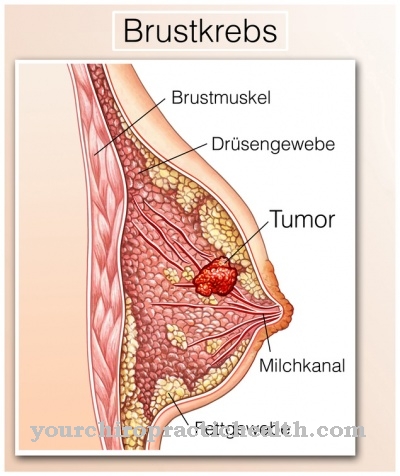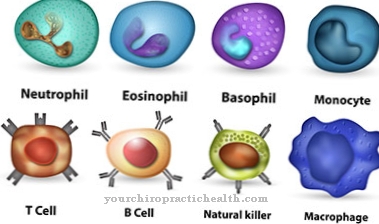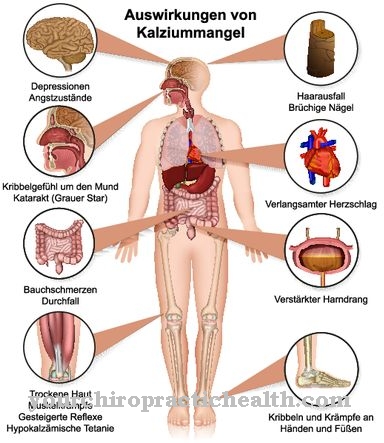Used in an ultrasound scan during pregnancy Neural tube defect found, this is a big shock for the parents-to-be. Depending on the severity of this malformation, the baby will not be able to survive or it will be born with a disability, in some cases severe. In Germany, the risk of having a child with a neural tube defect is around 1 in 1000. To prevent this from happening in the first place, every woman of childbearing age should take appropriate precautions and consume enough folic acid in good time.
What is a neural tube defect?

© serhiibobyk - stock.adobe.com
A Neural tube defect arises from a developmental disorder between the 18th and the 28th day after conception. During this time, the precursor to the nervous system, the neural plate, forms in the embryo. Initially, it is an elongated indentation in an area that will later develop towards the child's back. As the cells continue to divide, this indentation closes up to the 28th day after the egg and sperm cell connect to the neural tube, from which the spinal cord, spine, brain and skull arise.
If there is a neural tube defect, it does not close completely. This defect can occur in one or more places in the future spine and vary in size. The result is a so-called "open back", a spina bifida or anencephaly. Anencephaly means translated "without a brain".
Babies born with this severe form of neural tube defect are missing large parts of the brain and the roof of the skull. These children are not viable. They are either born dead or die shortly after birth.
causes
A neural tube defect can have many causes. They can be genetic, based on chromosomal disorders or caused by metabolic influences and harmful substances. A virus infection, for example with rubella, high fever or exposure to radiation from X-rays or a CT scan in early pregnancy can also trigger a neural tube defect.
Furthermore, women who have to take anti-epileptic drugs and women with type 1 diabetes are at risk, especially if they are poorly adjusted. Folic acid deficiency is another possible cause.
Symptoms, ailments & signs
The symptoms of spina bifida depend on the area in which the spine is damaged and whether the spinal cord bulges outwards through the gap in the neural tube. In the mild form, spina bifida occulta, affected people often do not know anything about their malformation unless a doctor determines it during an X-ray examination.
Such a neural tube defect causes unspecific complaints such as back pain, skin changes in the area of the spinal column defect or a weakness of the bladder sphincter muscle. However, if the spinal cord or the meninges are affected by the neural tube defect and the nerve tissue is damaged, the spectrum of complaints ranges from minor movement disorders to paraplegia.
Other symptoms that can occur are scoliosis (a curvature of the spine), muscle wasting and joint deformities. Spina bifida rarely causes brain damage. However, some infants develop hydrocephalus when the back of the cerebellum protrudes into the spinal canal. This does not cause brain damage, but it can affect the circulation of cerebrospinal fluid. Most of the children affected are normal intelligent.
Diagnosis & course of disease
A neural tube defect is usually detected by the ultrasound examination. Large defects in the neural tube are already visible after a gestation period of twelve weeks. Less pronounced vertebral deviations can be found between sixteen and twenty weeks.
However, if the back of the fetus is difficult to assess or if there is a high risk, an additional amniotic fluid test may be necessary. The triple test (blood test) in the fourth month of pregnancy is less informative.
Complications
Whether there are complications with a neural tube defect depends on where the defect is located. A particularly extreme form of neural tube malformation, anencephaly, is not compatible with life because large parts of the brain do not even develop here. The newborn dies after a few weeks. The second form of neural tube defect, spina bifida, shows different appearances with different effects.
So the defect can go completely unnoticed if the spinal cord is not involved. If the spinal cord is involved and the defect is open and the nerve tissue is exposed, the neural tube must be surgically closed immediately after birth or even beforehand. Otherwise there is a risk of a serious infection that can be fatal. Even after that, most patients require lifelong care. In severe cases, those affected are at risk of paraplegia. Some patients suffer from urinary and fecal incontinence.
Sometimes it also happens that both the spinal cord and the brain are affected. Then the mental development of the child can also be negatively influenced. However, precise statements on the relevant prognosis cannot be made. In most cases, the children develop normally with intelligence. Often there is also a neurogenic bladder, which requires constant medical treatment, as otherwise the loss of kidney function could result as a complication.
When should you go to the doctor?
Neural tube defects arise in the closely monitored first trimester of pregnancy. That is why it is very important so early that the woman regularly attends the preventive medical check-ups. In this context, a neural tube defect can be detected and treated in the fetus. In this way, the later consequences after the birth can at best be contained to such an extent that the baby can lead a largely normal life.
If a neural tube defect is so severe that the child would be born with a disability, the woman can now decide to have a late abortion. Prevention during pregnancy is also important in order to identify possible nutrient deficiencies and other risk factors for a neural tube defect and to be able to intervene in good time. If a baby is born with a neural tube defect, the pediatrician is challenged immediately after the birth and must determine whether the ultrasound images match the actual state of health of the newborn.
Many newborns, depending on the type and severity of the neural tube defect, need surgery immediately after birth, because the earlier the treatment takes place, the better a congenital neural tube defect can be treated.Any surgical scars also heal quite well at such an early age and can become almost invisible in later life. In this way, the newborn can still have a normal life.
Treatment & Therapy
American scientists began to close a neural tube defect prenatally 20 years ago. In order to reach the baby, the abdomen and uterus had to be opened through larger incisions. In the meantime, a minimally invasive surgical method has been developed with which a spina bifida can be closed in the womb - German Center for Fetal Surgery and Minimally Invasive Therapy (DZFT).
This prenatal procedure has beneficial effects on the function of the lower extremities as well as the bladder and rectum. The formation of a water head can also be limited. The best prerequisites for this procedure are at the beginning of the 20s pregnancy. If babies are born with an open back, germs can invade and cause further nerve damage.
Therefore, the exposed spinal cord structures must be surgically closed in the first one to two days after birth. If a head of water is also diagnosed, an artificial drain is created for the excess brain water. Regular emptying of the bladder and bowel must also be ensured if there is paralysis.
For affected children, a high-fiber diet and adequate fluid intake are important to keep the stool soft. The aim of subsequent therapy will be to give the children a lot of independence and mobility. A pediatrician is familiar with the various specialist areas that can help. He can coordinate and ensure the exchange of information.
Outlook & forecast
The resulting disease is important for the prognosis of neural tube defects. If the defect manifests itself in the form of spina bifida occulta, those affected usually do not notice the malformation and it is possible to lead a normal life.
The situation is different with myelomeningocele. This is a serious disease that can cause serious problems in childhood and adolescence as well as in adult life. This disease often results in infections, problems with the urinary tract and kidneys, symptoms of paralysis and hydrocephalus (head of water). Often those affected also show significant difficulties on a social level, intellectual disabilities and psychiatric problems are not uncommon. Very severe cases also show extensive damage, which extremely reduces the survivability of the affected children. But even with myelomeningocele, most of those affected can lead a good life and integrate into both social and professional life.
Treatment of a neural tube defect always involves surgery. Depending on the type and severity, this usually takes place immediately after the birth. This is particularly important for the prognosis, because the earlier the treatment is carried out, the better the prospects for later life.
prevention
The best precautionary measure against a neural tube defect is an adequate supply of folic acid at the latest at the beginning of pregnancy, even better when the desire to have children becomes manifest. A developing baby needs this vitamin for their cells, tissues and organs. It plays an important role in the development of the brain and spinal cord. A sufficient supply of folic acid minimizes the risk of a neural tube defect by half.
You can do that yourself
When the prospective parents learn that their child has a neural tube defect, it is initially a shock. This is especially true if it is a serious defect that the child is unlikely to survive. Other forms of neural tube defects can possibly be corrected surgically during pregnancy (prenatal) or a few days after birth.
Children with a neural tube defect are usually dependent on help for the rest of their lives. That makes it very difficult for the parents of the affected children. Depending on the individual diagnosis of the defect, psychotherapeutic support or various self-help groups can help. Help for self-help is provided on the one hand by the anencephaly information page (www.anencephaly.info), which provides information in several languages. Another Internet address is that of the Spina Bifida and Hydrocephalus e. V., a self-help group that has existed since 1966 (www.asbh.de). In the worst of all cases, the Federal Association of Orphaned Parents and Grieving Siblings in Germany e.V. (www.veid.de) helps.
It is generally helpful for patients with a neural tube defect to drink a lot and eat a diet rich in fiber. Both are intended to keep the stool soft and thus facilitate bowel movements. Physiotherapy allows the patient to become and remain flexible and thus independent. The therapies prescribed by the doctor should therefore be used.



.jpg)
.jpg)






















